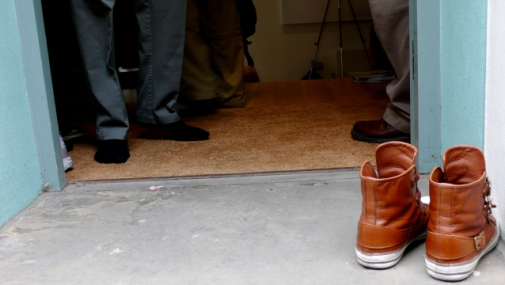You may have heard that mindfulness practice—learning to pay curious and kind attention to the present moment—brings a wide-ranging host of benefits to the classroom or workplace setting. Greater focus, improved self-awareness and collaboration, reduced anxiety and hostility: the evidence-based, scientifically-demonstrated list goes on.

Mindfulness can bring ripples of benefit to any classroom or workplace setting.
Image courtesy of Pixabay.
Thankfully, you need not polish your pedagogy or meditate in a monastery for months on end in order to start reaping such benefits. These five easy-to-introduce mindfulness practices will have immediate effect and will plant valuable seeds for further exploration.
- Minute of silence and stillness. Almost everyone’s in some bit of swirl when they begin a class or arrive at a meeting. Taking a minute of quiet stillness allows folks to catch their breath and settle their minds before diving into a new experience.
Many students will ask “What should I do during that time?” One helpful answer: “You don’t have to do anything. For this minute, you can just be.” Suggest that folks bring attention to their own experience during that time. What can they notice about their breath, their body, or the sounds coming to their ears? What’s happening now?
Insider tips
- Invite students to close their eyes or find a neutral spot of focus on the floor or desk in front of them. Some groups need time to work out their nervous giggles and desire to distract—most have little experience with shared silence—but eventually students come to cherish the quiet respite.[1]
-
Some participants may ask, “Am I supposed to pray?” My response: it’s a time to bring yourself to the present moment, to let go of—or at least note—whatever tensions or concerns you’re bringing into the room so you can concentrate on what we’re doing here. If a silent prayer helps with that, go ahead and pray.[2] It’s an option, but most definitely not a requirement.
- Using a chime or other peaceful sound to enter into and exit the silence helps to punctuate the transition as well. Letting the kids or other participants ring the chime gives them further ownership over the practice.
- Deep listening. When most of us listen, we’re rarely paying full attention—we’re preparing a critique or a response instead. Deep listening develops a more generous, focused presence that leads to real connection.
Group your students or colleagues into pairs with each partner facing the other. If you can, give enough space so that pairs won’t distract each other. One person starts as the speaker, responding for a set time to a basic prompt; the other simply listens. No questions, no feedback, no clarification, no striving to remember or respond. Just listening. If the speaker feels she has finished before the minute concludes, the two can sit in silence until more thoughts come—and often the best sharings emerge from that quiet—or until time’s up.

This dog knows how to make the phonograph feel heard. Good deep listening, pooch.
Image courtesy of Wikipedia.
Then, switch roles so the second speaker shares his own reflection to that same prompt. After each participant has had the chance to speak, the pair gets a third minute to dialogue like in normal conversational. Is there anything your partner mentioned that you appreciated or wanted to connect with? Did their comments raise any questions? And so on.
Doing this exercise early in a semester or project can generate a sense of community that pays dividends for the rest of the group’s time together, especially if you go through several rounds with new partners for each subsequent question.
Insider tips:
- After a first session of deep listening, engage a group discussion to explore what it was like to speak and listen this way. Most likely you’ll hear a range: “It was weird.” “I didn’t know how to respond.” “I felt safe.” “I got time to hear my own voice.” “Knowing I wasn’t going to respond meant I could pay better attention.” “I felt like I wasn’t being kind.” Whatever, the responses, welcome them and acknowledge that skillful deep listening takes practice and, eventually, bears good fruit.
- Early on, good prompts will ask non-threatening, open-ended questions that invite participants to share something authentic without getting too vulnerable. “What’s something you enjoy doing over the summer?” would work well. “What’s one of your deepest fears?” would prove unfair, if not irresponsible. Once a group has established greater familiarity, of course, deep listening offers a good structure for more intimate sharing. Be cautious and patient with testing such boundaries.
- Forming “wheel-within-a-wheel” circles can help transition from partner to partner. Have one partner from each group help form a circle in the center with their chairs facing out. The other partners then form a second, wider circle by facing their chairs toward the center. Each pair forms a “spoke” radiating outward. After the first question, have the folks in the inner circle stand and move one partner to their right (clockwise). After the second question, have the folks in the outer circle stand and move one partner to their right (counter-clockwise). Everyone gets to move. Everyone meets new people.
- Where is your attention now? Like a spotlight, our attention always shines somewhere. With practice, we can learn to choose where that awareness falls, rather than lurching to and fro without intention. Every so often—including in the middle of other exercises or projects—ask your students “Where is your attention now?” and then give them a moment or two to stop and notice. Is their attention where they want it to be? Great. Has it gone elsewhere? That’s fine too. Either way, they’re developing an awareness about their awareness—and that they have some choice in the matter.
Insider tip:
- Take care with your vocal tone when delivering the question. Avoid judgment or reprimand as in “Get your attention back here now!” Rather, invite curiosity and kindness in exploration, as in “Hmm. Check that out. My mind has wandered off entirely. What do I want to do about that.”
4. Breathing ratio. This simple breathing exercise takes just a moment and can help restore calm in a time of stress or chaos—without anyone else needing to know. Invite students to silently count as they inhale and start counting again as they exhale. There’s no need to adjust posture or shift breathing pace; again, they’re simply noticing what is. What number do they find on the in breath and on the out breath? Are they different? Do they change?
Insider tip:
- Ask students to take stock of how they’re feeling in mind and body before they start the exercise and then again after they’ve finished. Almost universally, students experience greater groundedness—and an excitement to learn that they can create this sense of calm whenever they need it.
- Recognize transitions. Skillful mindfulness teachers will find others ways to mark transitions between lessons, activities, or learning modes. Maybe students take shoes off or drop cell phones into a box on their way into the classroom. Perhaps a quick pick-me-up game sloughs off the stress following a test. Or a slow, silent walk around the desks introduces a different kind of focus.
One of my favorites signals the end of class rather than having kids just trickle away without intention. Students put one hand toward the center of the room, as if forming spokes in one large wheel. Together, we’ll count to three and then lift our arms out, chanting “Spokes out!” The simple practice takes about 5 seconds but gathers the group’s energy one last time. We honor what we’ve shared and honor where we’re going.
Insider tip:
- Infinite possibilities abound for this one. Find your own creative ways to mark transitions or, better yet, invite the students to generate their own.
Whatever approach you choose, remember that the more your kids practice some form of mindfulness, the more they (and you) will see its mind-shifting benefits. As is so often true, the oxygen principle holds: best to get your own mindfulness practice going before bringing your students to it. If you want to teach swimming, it helps to have survived a few swimming situations of your own.
A few words of caution to conclude. Sloppy or unskillful introductions to mindfulness may generate hesitation or even defiance—and such resistance can surface with surprising intensity. For one, mindfulness instruction can trigger sensitive religious concerns. Wise teachers and leaders learn to anticipate how even avowedly secular practices might threaten some faith traditions—or privilege others. In addition, deeper exercises—extended meditations, body scans, or movement practices—often bring up difficult emotions or memories. Any teacher who hasn’t explored his or her own inner landscape will have little to offer a student or colleague facing the challenge of theirs. Again, healthy humility, steady patience and a commitment to one’s own daily mindfulness practice all make good sense here.
[1] You know things are going well when your students remind you that you forgot the opening minute.
[2] Lord knows, I’ve often asked for guidance or good words before a challenging class!






That was perfect! Thank you for this simple, sussinct post.
Glad that was helpful, Sue. More to come!
Powerful ways to enhance and build community in a classroom. thanks, Ted!
Thanks for your kind words, Melissa. Let me know how they work for you!